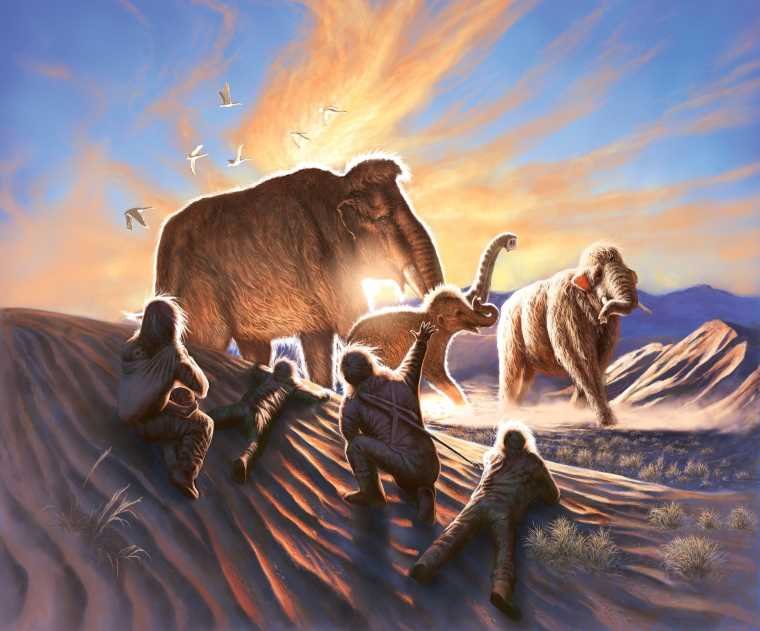New scientific evidence supports the likelihood that ancient humans living in modern-day Alaska actively tracked, hunted, and killed wooly mammoths as early as 14,000 years ago, according to new research.
The remains of one mammoth, named Élmayųujey’eh (or Elma for short) by researchers involved in the new research, were found surrounded by evidence of an ancient human hunting camp. Further findings, including isotopic analysis, indicate that these hunters likely tracked entire groups of mammoths across part of the Bering Strait that connected Asia to the Americas during the last Ice Age.
14,000 Years Ago, Ancient Humans Hunted Wooly Mammoths
In 2009, Charles Holmes, an affiliate research professor of anthropology at the University of Alaska, Fairbanks (UAF), and François Lanoë, a research associate in archaeology at the University of Alaska Museum of the North, were working at the Swan Point archaeological site in Interior Alaska, when they unearthed an ancient mammoth tusk along with evidence of other mammoths. They also noted that these remains were surrounded by evidence of campfires, human use of stone tools, and even the butchered remains of other game animals.
According to Ben Potter, an archaeologist and professor of anthropology at UAF, all of this evidence taken together “indicates a pattern consistent with human hunting of mammoths.” Still, it was not clear whether or not this was an isolated incident or evidence that humans actively tracked and hunted mammoths, similar to the way ancient Americans moved their camps to follow buffalo herds.


Hoping to shed more light on this mystery, a team of UFA researchers decided to use modern technology to dissect the travels of Elma and other mammoths found in the area to see if humans indeed tracked and hunted mammoths. Their results seem to support the notion that ancient humans did indeed build their encampments to coincide with the places where mammoths gathered.
Isotopic Analysis Paints Vivid Picture of Mammoth Movements and Human Hunters 14,000 Years Ago
To better understand the areas where mammoths concentrated 14,000 years ago, the UAF research teams performed a detailed isotopic analysis of Elma’s recovered tusk, along with other mammoth remains from the area. Isotopes are a valuable tool for archaeologists, as they can provide chemical markers that reveal an animal’s diet and location. Significantly, these markers remain effectively “recorded” in the bones and tissues of animals after they die.
According to the press release announcing their findings, Mammoth tusks are also “well-suited” to isotopic analysis “because they grew throughout the ancient animals’ lives, with clearly visible layers appearing when split lengthwise.” By following these layers, like botanists counting the rings on a growing tree and correlating specific isotopes from various plants and other organic matter in the area, the UAF team was able to paint a vivid picture of Elma’s movements throughout her entire life.
The analysis revealed that Elsa was a 20-year-old healthy female mammoth who appeared to travel roughly 1,000 kilometers across parts of Alaska and northwestern Canada throughout her lifetime. More importantly, and as the researchers suspected, Elma’s movements were highly correlated with the densest collection of ancient human settlements found in the region.
“She wandered around the densest region of archaeological sites in Alaska,” said Audrey Rowe, a UAF Ph.D. student and lead author of the paper. “It looks like these early people were establishing hunting camps in areas that were frequented by mammoths.”
Follow-up analysis of DNA from other mammoths found in the area also seemed to back up this assumption. Wherever the researchers found evidence of mammoth travels, there was also concentrated evidence of ancient human hunting activity.
Climate Change May Have Increased Human Predation of Wooly Mammoths
In their published study, which appears in the journal Science Advances, the researchers show that Elma was a healthy animal and that her movements were remarkably similar to those of another mammoth that lived 3,000 years earlier.
“She was a young adult in the prime of life,” said senior author Matthew Wooller, who is director of the Alaska Stable Isotope Facility and a professor at UAF’s College of Fisheries and Ocean Sciences. “Her isotopes showed she was not malnourished and that she died in the same season as the seasonal hunting camp at Swan Point where her tusk was found.”
In their conclusions, the researchers note that the now-extinct species was not only likely hunted by ancient humans but that changes in their habitat 14,000 years ago may have aided ancient humans in those hunting efforts.
“Climate change at the end of the ice age fragmented mammoths’ preferred open habitat,” Potter explained, noting that the mostly grass and shrub-steppe landscape of ancient interior Alaska was changing to a more forested one, “potentially decreasing movement and making them more vulnerable to human predation.”
Christopher Plain is a Science Fiction and Fantasy novelist and Head Science Writer at The Debrief. Follow and connect with him on X, learn about his books at plainfiction.com, or email him directly at christopher@thedebrief.org.

